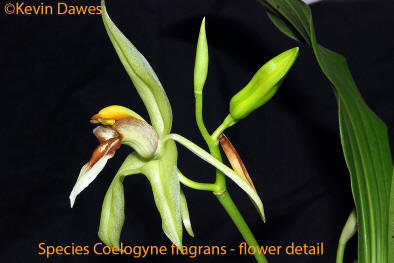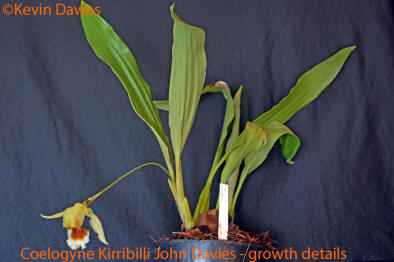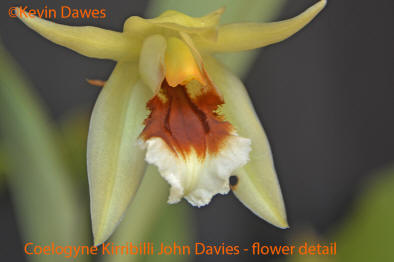Coelogyne Kirribilli John Davies is one more new (2016) primary Coelogyne hybrid plant. A primary hybrid is one made by cross-fertilising two species plants - in this case, Coelogyne calcicola and Coelogyne fragrans (the top two images). This hybrid cross is a bit more adventurous in that it has moved away a bit from the more commonly grown species in an effort to explore new hybridising territory and also using less closely related species. Hybridising Coelogynes is so much in its infancy and hopefully this hybrid will contribute a little more information to the process.
Coelogyne calcicola (from limestone/calcium areas such as Yunnan, China) is little known in Australia and belongs to a group of Coelogynes that includes Coelogyne stricta. Both these plants have thick long rhizomes (runners) that make it difficult to contain within a normal pot. This major trait is very suppressed within the hybrid. Much of its fimbriation (hairiness) around the mid lobes and on the keels has also carried through to the hybrid as well as a lot of crenations (folds/wrinkles) around the edge of the lip. The single flower on this seedling has taken many weeks to open (as happens with the parent) but on a slightly weaker stem. The sepals of the mother are very horizontal and, to me, add a look to the flower reminiscent of a charging bull. This trait has been slightly modified in that they are less horizontal.
The pollen parent has had major influence, most notably in passing on much greener tinting in the sepals and petals and suppressing the delicate white that makes the pod parent so attractive. Likewise, Coelogyne fragrans has passed on fairly clear brown colouring inside the flower lobes and well covering the throat areas of the flower. This has been at the expense of the rather pretty orange and gold markings of the mother flower. The whitish column of Coelogyne calcicola has given way to a greenish colouring with a slight hint of orange at the tip. A very obvious trait variation is the much more compact rhizome in the hybrid.
The hybrid flower has lost its perky white and gold/yellow appearance and the tonings are much reduced and more similar to Coelogyne fragrans. The flowers have increased in size from the mother to be much more similar to Coelogyne fragrans. At this stage, with only one flower on the seedling, it is not possible to predict how many flowers will be produced on the hybrid. Both parents normally produce 5 - 6 flowers per spike but Coelogyne fragrans can sometimes tend to flower less simultaneously.
Both parent species are found reaching into higher altitudes and cooler zones. Therefore, it could be expected that this hybrid could be a little less tropical than some other species, especially given the hybrid vigour factor.
This hybrid was pollinated 24.11.2010 and dry seed sown into flasks on 2.9.2011 after the pod split when a little over nine months old. Normally Coelogyne pods last for 12 months with a few (Coelogyne speciosa) lasting a little longer. (Normally a plant needs to get its seeds developed and dispersed and have time to build up energy reserves before it starts the whole flowering/breeding process all over again). The first seedling flowered on the 28.10.2016 enabling registration with the RHS to be completed.
Although germination was reasonable the protocorms (germinating seeds) lacked vigour and the deflasked seedlings struggled in comparison to other Coelogyne hybrid seedlings. Another Coelogyne calcicola hybrid (Coelogyne Kirribilli Jimmy) has also struggled. My registered Coelogyne Kirribilli Norm (Coelogyne speciosa x Coelogyne fragans) is an extremely vigourous, prolific flowering orchid. Based on this extremely limited data I suspect Coelogyne calcicola to be a weak breeding parent. This needs more empirical data. On a positive note, this rudimentary hybridising is leading us on and filling more information into the Coelogyne hybrid breeding knowledge vacuum.
Negatives: This hybrid has slightly muted colours compared to the so-called "white" Coelogynes and perhaps not as spectacular markings as some of the new Coelogyne SPECIOSAE type hybrids. Coelogyne fragrans, the pollen parent, is so named because of its fragrance. There is only the smallest hint of perfume in this seedling at times. The psuedobulb clustering is fairly open, making for a less compact plant. However, this is the first flower on a seedling plant and generally all seedlings improve with age and subsequent flowerings.
Rating: ♦♦♦ These flowers are very upright, open and a good 7cm across. A couple of years may be needed before it can be rated against a straight species Coelogyne fragrans. It cannot be compared favourably against its pod parent in terms of colouring but Coelogyne calcicola is still selling at great prices (around $300 in Australia) making it strictly a collectors orchid. This hybrid flower is fairly similar in appearance to the rare Coelogyne tommii species in terms of colour, size and shape.
Registration: Registration with the RHS as Coelogyne was recorded in November 2016. This hybrid was named in honour of the late John Davies who was not only a family relative, a great cook, dog lover and gardener but a wonderful mentor and a dear friend to all who knew him.
Varieties: None known.
Hybrids: None registered
| < Coel Kirribilli Jimmy | Coel Kirribilli Joyce > |


